с 21.08.2015 по настоящее время
с 25.11.1947 по настоящее время
BISAC NAT010000 Ecology
BISAC NAT045050 Ecosystems & Habitats / Coastal Regions & Shorelines
BISAC NAT025000 Ecosystems & Habitats / Oceans & Seas
BISAC NAT045030 Ecosystems & Habitats / Polar Regions
BISAC SCI081000 Earth Sciences / Hydrology
BISAC SCI092000 Global Warming & Climate Change
BISAC SCI020000 Life Sciences / Ecology
BISAC SCI039000 Life Sciences / Marine Biology
BISAC SOC053000 Regional Studies
BISAC TEC060000 Marine & Naval
Laboratory investigation of eddy formation mechanism due to spatially non-uniform wind impact was fulfilled. Experiment was provided in a cylindrical and a square form tank filled with homogeneous or stratified fluid and displaced on a rotating platform. In the absence of the platform rotation, an impact of the single air jet lead to the formation of a symmetric vortex dipole structure that occupied the whole water area in the tank. In the presence of the platform rotation, a compact anticyclonic eddy was formed in a part of the dipole with anticyclonic vorticity, while in a part with cyclonic vorticity no any compact eddy was observed. The laboratory results were successfully compared with the field observation results fulfilled in the at the Black Sea coastal zone near Gelendzhik.
Black Sea, spatially non-uniform wind forcing, submesoscale eddies, laboratory study.
I. Introduction
To a practice of an ecological monitoring of the coastal (shelf) areas in the north-eastern part of the Black Sea, in the recent past has been introduced a new instrumental and methodological approach that provides high spatial and temporal resolution of the measurements. An important result of this approach was a frequent observation of submesoscale (with a diameter of 2-10 km) intense eddies, both cyclonic and anticyclonic. Apparently, these eddies play a significant role in cross shelf water exchange and energy dissipation of the alongshore currents [1, 2].

Fig. 1. The satellite SAR image of the north-eastern part of the
There are at least three possible mechanisms of the submesoscale eddies formation. First mechanism - a periodic formation of eddies behind the capes. It was revealed that in a rotating fluid due to this mechanism only anticyclonic eddies are formed periodically in decelerating cyclonic coastal current [3]. Second mechanism is the shear instability of the coastal current. Due to this mechanism in the rotating fluid the cyclonic eddies are formed predominantly [4]. The third mechanism related to spatially inhomogeneous wind forcing is a subject of a study in this paper.
Coastal zones of many seas (Black Sea, in particular) are surrounded by hills and mountain ranges separated by valleys. Wind directed from the seashore often has a different velocity over the valleys and over the mountains. Due to the complicated orography of the coast the offshore wind over the sea often consists of quasi-parallel wind jets as it is presented at figure 1. The presence of wind jets, separated by the regions with weaker winds, should lead to the formation convergent and divergent Ekman transport and of the furrows-like anomalies of the sea surface level. The instability of such structures could provoke the formation of the mesoscale or submesocale eddy-like structures [5].
The aim of this work is to conduct laboratory experiments to study the possibility of eddy formation in a homogeneous and two-layer non-rotating and rotating fluid due to the impact of one or two offshore air jets parallel to each other.
II. Laboratory setup
Two series of experimental runs in the tanks with different shapes and sizes were conducted.
In the first series the experimental runs were carried out in cylindrical tank with a diameter of 60 cm and a height of 8 cm, filled with distillated water and placed on a rotating platform. Runs were conducted with and without of the platform rotation. The time period of the platform rotation was as follows: 15 s, 10 s and 5 s (the Coriolis parameter f = 2Ώ = 0,8 s-1, 1.25 s -1, 2.5 s -1, respectively). A video camera was placed at the center of the platform above the tank.
Some of the experimental runs were fulfilled in homogeneous fluid, and the others – in two-layer salinity stratified fluid. To create a two-layer salinity stratification a thin (2 cm) layer of the distilled water was accurately flooded over the thicker layer (5 or 25 cm) of the salted water (5, 10 or 20 psu) that was already promoted to the state of solid-body rotation with angular frequency Ώ. This method allowed us to minimize the mixing between the layers.
Near the wall of the circular tank four wind blowers with nozzles of 7 cm width were installed. Three of them were directed at an angle of about 70 degrees to the radius of the tank and were used to produce azimuthal wind stress and coastal rim current. The fourth blower was directed radially towards the center of the tank and was used to create the the air stream normal to the shore (Fig. 2a, b).
At the beginning of each experimental run, fine paper pellets were dropped at the water surface for flow visualization. These pellets played a role of passive tracers. In the absence of a azimuthal wind stress and coastal rim current the fourth blower turn on at once with the video camera. In the opposite case the camera was switched on together with the three wind blowers. The fourth wind blower was switch on for a definite time interval (from 5 to 80 s) only when coastal rim current was fully generated.
The velocity V of the wind in different experimental runs varied in the range of from 2 to 8 m/s at a distance of 5 cm from the wind blower nozzles and from 1 to 5 m/s at a distance of 15 cm from them.
The second series of the experimental runs was carried out in a square form tank with a width of 70 cm and height of 10 cm. It was filled by distilled water up to the top. In this series of experimental runs only two wind blowers were used in order to investigate the impact of the parallel neighboring wind jets on the eddy formation in the underlying water layer. Both of them were installed normally to the same side of the tank. One of them was located at a distance 7 cm from the tank corner. The position of the other one was changed from one experimental run to the other and the distance between the blowers L varied from one experimental run to the other as follows: L = 20, 30 and 40 cm. In order to reduce the end wall effect on the results of experiment, approximately one-third part of the water surface near the wall opposite to the blowers was closed by thin organic glass plate. For the comparison with the results of the experiments in circular tank, some experimental runs in a square form tank were conducted with one wind blower installed at the middle of the tank wall (Fig. 2c, d).
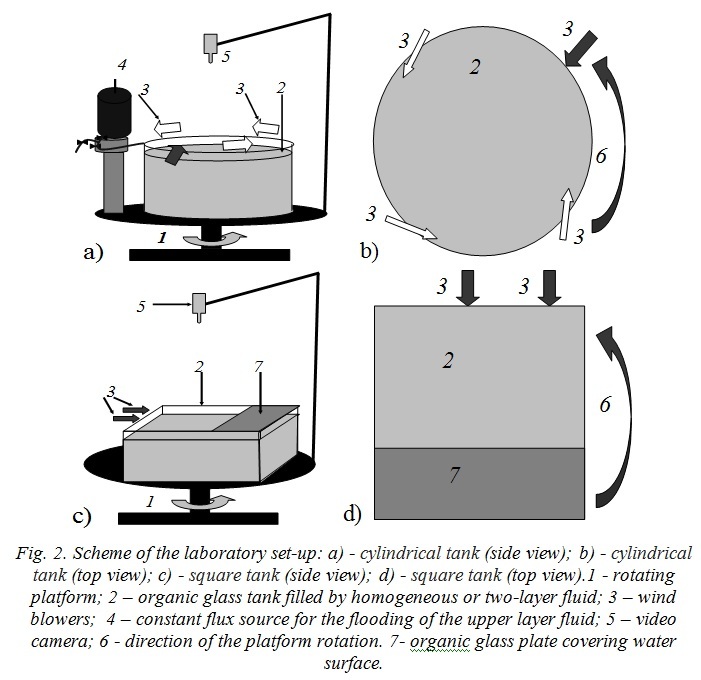
III. Estimate of wind stress and surface current velocity
One of the basic parameters of the experiment is a wind stress at the water surface generated by the wind blower. It could be expressed as follows:

Here Ua is the wind velocity (m/s) at a curtain height za above the air-water interface (for the sea za = 10 m), Cd – non-dimensional drag coefficient, ρa = 1.29 kg/m3 – density of air. For the natural conditions Cd = (1-2)10-3 [6, 7]. But for the certain conditions of the laboratory experiment the value of Cd is unknown. It could be estimated on the base of the theory of turbulent boundary layer and measurements.
Let us divide the air flow above the water layer in the laboratory tank into three zones in vertical direction: 1 - the near surface zone, or the laminar sublayer; 2 – the turbulent zone with constant shear stress, or “logarithmic” sublayer; 3 – the core of the flow, where the air velocity is maximal and nearly constant (Fig.3).


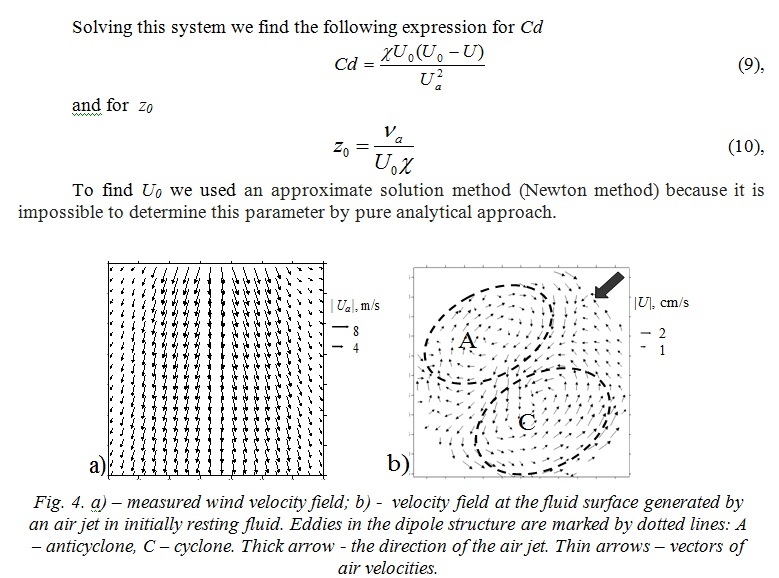
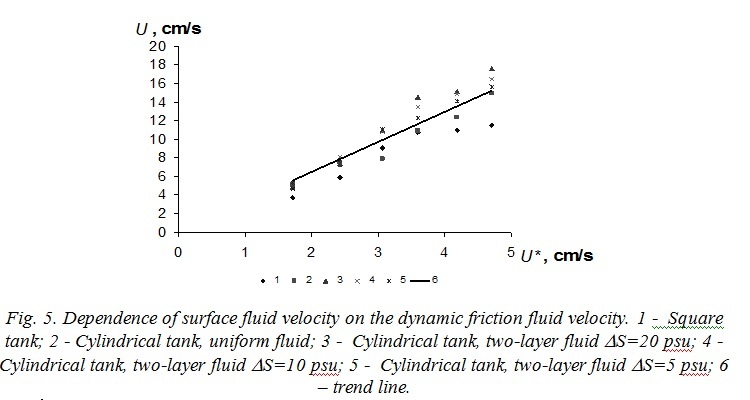
Starting from the condition of continuity of the momentum flux in vertical direction in zones 1 and 2, let us equate the expression for the wind stress on the upper boundary of zone 1 to the expression for this quantity at the lower boundary of zone 2:
To find U0 we used an approximate solution method (
Using the data of our experiments it was found that in the laboratory conditions Cd = (2.5±0.2)*10-2. This value is higher by more than an order of magnitude the value of Cd for wind flows above the sea surface.
The estimated value of wind stress in laboratory conditions τ changed in the range of 0.3 – 2.2 kg/ms2 at distance 5 cm from wind blowers nozzle depending on the value of the wind velocity. Respectively the value of the dynamic friction velocity in water, U* = (τ/ρw)0.5, where ρw – the density of water, changed in the range 1.7 – 4.7 cm/s. At a distance 15 cm from blowers nozzle that is closer to the area of eddy formation in the laboratory tank, the value of wind stress varied from 0.034 to 0.8 kg/ms2, and the value of the dynamic friction velocity in water - from 0.6 to 2.8 cm/s. Approximately the same values these parameters have in the natural conditions at the sea surface if the wind velocity at 10 m height is changing in the range of 5-15 m/s.
The wind velocity field produced by the single blower directed radially towards the center of the tank is shown in figure 4a. Dependence of surface current velocity U in water just below the axis of wind jet on dynamic friction velocity in water is shown in figure 5. It is close to the linear one: U=3.2U1*, where U1* - dynamic friction velocity in water. The surface current velocity was determined by the short-term pellets displacement measurements at a distance 5 cm from the wind blower nozzile.
Video data of each experiment were processed using a special computer program for calculation of flow velocity vectors from the data on short-term pellets displacement. The results of the calculations were used to analyze the structure and quantitative characteristics of the surface currents produced by wind blowers in a homogeneous or two-layered, non-rotating or rotating fluid in the cylindrical and square form tanks.
IV. Results of the experiment in the cylindrical tank
In the absence of the platform rotation an impact of the single air jet lead to the formation of a symmetric vortex structure dipole that occupies the whole water area in the tank (Fig. 4b). In the presence of the platform rotation single air jet also generates the dipole vortex structure in the underlying fluid. But this structure is asymmetric: in a region with anticyclonic vorticity a compact anticyclonic eddy is formed. It is revealed that if the value of the parameter U/f <0.3R, where R is the radius of the tank, vortex core has a radius Re = U/f, where U is the flow velocity in fluid at the axis of the dipole structure. If the value of U/f> 0.3R than Re = 0.3R. The maximal orbital velocity in the compact eddy, Uorb = 0.7U. In a region with cyclonic vorticity no compact cyclonic eddy was observed.
In a homogeneous rotating fluid the dynamical structures vanished in a short time due to bottom friction after the end of wind forcing. In a two-layer rotating fluid the compact anticyclonic vortex existed much longer time, as a result of geostrophic adjustment and low friction at the density interface. The surface currents generated by the air jet in the rotating two-layer fluid are shown in figure 6. The dependences of Re/R , Uorb/Rf , Uorb/U and eddy Rossby number Roe on U/fR are shown on figures 7a-d, respectively.
.jpg)
In the presence of an intense coastal rim current in a rotating fluid, the effect of the normal to the coast air jet was not accompanied by vortex structure formation. However, at the stage of the rim current relaxation the formation of the dipole vortex structure with compact anticyclonic eddy was revealed in case with rather strong wind forcing. Thus, the formation of the vortex dipole structure with compact anticyclonic eddy depends on the ratio between the intensities of coastal rim current and the offshore wind jet (Fig. 8) [8].
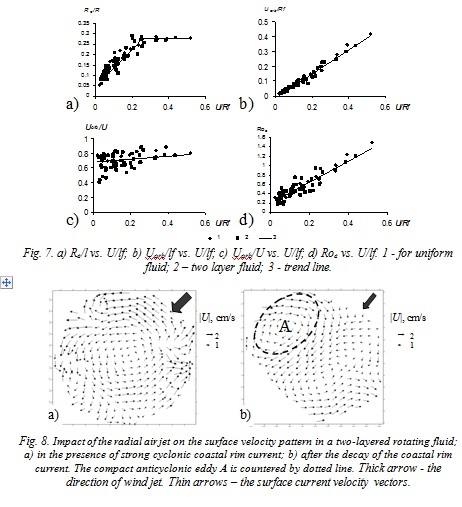
V. Results of the experiment in the square tank
In the square tank with one blower locate in the middle, in the absence of the platform rotation, impact of the air jet lead to the formation of a symmetric vortex structure dipole that occupied the whole water area in the tank. In the presence of the platform rotation single air jet also generated in the underlying fluid the dipole vortex structure. But this structure was asymmetric: in a region with anticyclonic vorticity a compact anticyclonic eddy Re = U/f was formed, where U is the flow velocity in fluid at the axis of the dipole structure. Do the results of experiment were just the same as in the case of cylindrical tank. The flows generated by the air jet at the surface of rotating fluid are shown in figure 9.
The wind velocity field produced by the action of two wind blowers is shown in figures 10a and 10b. In the absence of the platform rotation, if distance between blowers is small, than no eddy formation was observed in the water area between the blowers. If distance l between blowers was large (l >25 cm), the vortex dipole structures were formed by each of the blowers with no significant interaction between the air jets produced by these blowers.
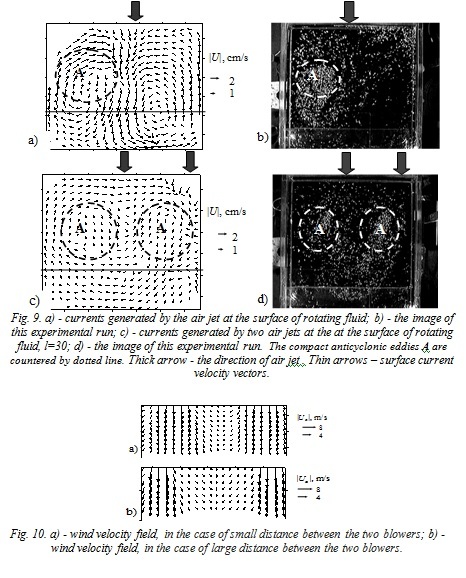
In the presence of the platform rotation and in the case of small distance between the blowers no eddy formation was observed in the water area between them. In the case of large distance between blowers a compact anticyclonic eddy was formed at the right side from each blower, while in a region with cyclonic vorticity no compact cyclonic eddy was observed. In that case the compact anticyclone eddy core had a radius Re = U/f with the maximal orbital velocity Uorb = 0.7U – the same as in the experimental runs with one blower.
It is reasonable to introduce and to analyze the non-dimensional parameter which characterizes the influence of the distance between blowers on the eddy formation between them. Such parameter is lf/U. It was revealed, that its critical value is about 5. If lf/U > 5, there is a formation of a compact anticyclone between the blowers, if lf/U < 5 – there is no compact anticyclonic eddy formation between them.
In the coastal zone of the north-eastern
VI. Conclusions
- In the absence of fluid rotation the offshore air jet generates the formation of a symmetrical vortex dipole in the underlying fluid layer.
- In the presence of fluid rotation the offshore air jet generates the formation of an asymmetrical vortex dipole in the underlying fluid layer. This dipole has a compact eddy in its anticyclonic part, while in its cyclonic part the vorticity was distributed rather uniformly.
- The life time of the vortex dipole is much longer in the rotating two-layered stratified fluid if compared to the case of rotating homogeneous fluid due to geostrophic adjustment and low friction at the density interface.
- In the presence of strong coastal rim current the offshore air jet usually does not generate the vortex dipole structure in the underlying fluid. In such case the possibility of the vortex dipole structure formation depends on the ratio between the intensities of coastal rim current and the offshore air jet.
- In the presence of two neighboring offshore wind jets impacting on the underlying rotating fluid layer the formation of compact anticyclonic eddy between them is determined by the non-dimensional parameter lf/U. If lf/U > 5, there is a formation of a compact anticyclone between the air jets, if lf/U < 5 – there is no compact anticyclonic eddy formation between them.
- The observed asymmetry in the formation of cyclonic and anticyclonic eddies under the influence of one or more offshore air jets in the described above laboratory experiments was also revealed in the natural conditions [9].
VII. Acknowledgement
The work was performed in the frame of RNF grant №14-50-00095.
1. Zatsein A.G., Korzh A.O., Kremenetskiy V.V. et al. Studies of the hydruphysical process ower the shelf and upper part of the continental slope of the Black Sea with the traditional and new observation techniques // Oceanology, 2008. V.48. №4 P.466-475.
2. Zatsein A.G., Kondrashov A.A., Korzh A.O., et al. Submesoscale eddies at the Caucasus Black Sea shelf and the mechanisms of their generation // Oceanology, 2011. V. 51. № 4. P. 554-567.
3. Elkin D.N., Zatsepin A.G. Laboratory Investigation of the Mechanism of the Periodic Eddy Formation Behind Capes in a Coastal Sea // Oceanology, 2013. V. 53. No.1 .P. 24-35.
4. Elkin D.N., Zatsepin A.G. Laboratory study of a shear instability of an Alongshore sea current // Oceanology, 2014. V.55. No.5. P. 576-582.
5. Zatsein A.G., Piotouh V.B., Korzh A.O., et al. Variability of currents in coastal zone of the Black sea from long-term measurements by bottom mounted ADCP // Okeanologiya, 2012. V.53. No.5. P. 579-592.
6. Garratt J.R. Review of drag coefficients over oceans and continents // Month. Weath. Rev. 1977. V. 105. P. 915-929.
7. Kondo J. Air-sea bulk model of the coefficients in diabatic conditions // Boundary-Layer Meteorol 1975. V. 9. № 1. P. 91-112.
8. Elkin D.N., Zatsein A.G., Kremenetskiy V.V. et al. Laboratory Study of the Generation Mechanism of Coastal Eddies in the Black Sea due to the Spatially Non-Uniform Wind Impact // Fluxes and structures in fluids. Selected Conference Papers. 2010. P. 117-121.
9. Ginzburg, A. I., Kostianoy A. G., Soloviev D. M. et al. Remotely sensed coastal/deep-basin water exchange processes in the Black Sea surface layer // Satellites, Oceanography and Society, Ed. D. Halpern, Elsevier Oceanography Series, 63, 273-287, 2000c.







